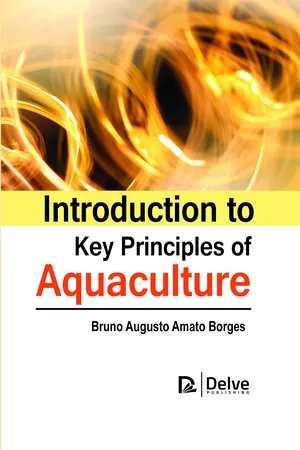
- 251 pages
- English
- PDF
- Only available on web
Introduction to key principles of aquaculture
About This Book
According to FAO's (1989) proposal, aquaculture is the cultivation of aquatic organisms, such as fish, crustaceans, mollusks, and aquatic plants. Traditional stocking, feeding, and safety from predators, among other factors, are all aspects of farming widely used to boost production. Additionally, farming implies individual or corporate tenure of the farmed stock. Aquatic organisms that are exploited by people as a shared property resource with or without proper licensing are the fisheries harvest, whereas aquatic organisms that are reaped by personal or corporate bodies that owned them during their rearing duration contribute to aquaculture for statistical purposes. The utilization of living aquatic resources in a continuous system from capture to culture is what this volume on aquaculture is all about. The relationship between aquaculture, agriculture, and fisheries is examined in light of its fundamentals and potential. Aquaculture has always made use of entrenched ideas, methods, and technologies from the cultivation of terrestrial florae and faunae. Agriculture, aquaculture, and fishing all end up producing final products that compete with one another or complement one another, make use of similar technologies for processing, conservation, or marketing, and call for the same type of research. In specific chapters, the volume provides in-depth descriptions of the general principles and originality of aquaculture art.
Frequently asked questions
Information
Table of contents
- Cover
- Half Title Page
- Title Page
- Copyright page
- About The Author
- Table of Contents
- List of Figures
- Abstract
- Preface
- Chapter 1: Introduction To Aquaculture
- Chapter 2: The History Of Aquaculture
- Chapter 3: Different Systems Of Aquaculture
- Chapter 4: Organic Aquaculture
- Chapter 5: Site Selection And Construction Of Fish Farms
- Chapter 6: Pre-stocking Management For Fish Ponds
- Chapter 7: Post-stocking Management For Fish Ponds
- Chapter 8: Physical, Chemical, And Biological Factors Affecting The Productivity Of Ponds
- Chapter 9: Fish Nutrition And Feed Management In Aquaculture
- Chapter 10: Fish Health Management In Culture System
- References
- Index
- Back Cover